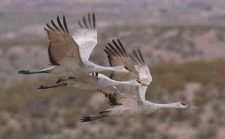
DUNCAN, Ariz. –-(Ammoland.com)- The morning sun hadn’t even flooded the fields of cut alfalfa and corn stubble, but the raucous trumpeting of sandhill cranes already was coming from all directions.
Inside a crude blind made of tumbleweeds and grasses, two hunters bundled up in camouflage quickly forgot that it was 30-something degrees and started searching the horizon for the large, gray birds bearing a distinctive red patch on their foreheads.
A few moments later, Johnathan O’Dell, small game biologist for the Arizona Game and Fish Department and longtime crane hunter, zeroed in on the first group of birds of opening day in Game Management Unit 28, a stone’s throw from the New Mexico state line.
“Here they come,” O’Dell whispered to his first-time hunting partner. “Don’t move.
“Wait . . .
‘Wait . . .”
Like a squadron of fighter jets, the cranes cupped their wings and dropped their long legs as they made their final approach over a spread of a dozen decoys that appeared to be feeding in a harvested alfalfa field.
Neither hunter moved.
“Not yet,” O’Dell whispered. “Let them come in.”
Only when the birds were gliding just above the decoys did O’Dell give the order.
“Get ready . . . OK, now!”
The scene was replayed several times through the day. When it was over, O’Dell had his three-bird limit, which included both lesser and greater subspecies, while his partner took two cranes, including a “Canada” that is larger than the lesser but smaller than the greater.
Arizona’s sandhill crane hunt permit-tags are obtained through the application and random draw process. Applications are accepted in August, with hunt permit-tags mailed out in September. A total of 510 hunt permit-tags (and another 25 for youth-only) were available for the 2016 general season, which is comprised of 10 three-day hunts (five in GMUs 30A, 30B, 31 and 32, and five more in GMU 28) that take place in November and December.

The hunt permit-tag fee is $43 for residents and $45 for non-residents (each hunter receives three hunt permit-tags). A valid Arizona hunting license and sandhill crane hunt permit-tag are required.
Sandhill cranes are the largest of North American game birds (sorry, wild turkey fans). An adult can have a wingspan of 6 to 7 feet, stand 3 to 4 feet tall, and weigh 6 to 12 pounds. With those dimensions, one might think all a hunter needs to do is show up opening morning and just wait for the big birds to drop by.
In fact, there’s a lot of preparation that goes into a successful hunt. It begins with locating birds in their wintering areas, then observing their flight patterns at least one or two days before you intend to hunt. At first light, cranes will start to leave their roosting areas in search of harvested grain fields in which to feed. The birds will return to the roost, or nearby “loafing” areas, during midday, then sometimes make short trips to feeding areas in late afternoon before returning to the roost.
The next step is seeking permission from landowners to hunt their fields. A few pointers: As a hunter, you are asking to be a guest on private property. That means be polite, courteous and respectful. Do not interfere with their day-to-day workings of the farm. Ask the landowner if he needs a helping hand with anything on the property. Above all, follow up after your hunt with a proper “thank you.”
“The landowners that let you on their property you want to be sure to treat very well, not only for yourself in the future but for the hunters who are coming after you,” O’Dell said. “Leave gates as you find them, pick up all of your trash, things like that.”
Once permission has been secured to hunt a particular field, or fields, it’s time to build a blind. The most important aspect of the blind is to break up the outline of the hunters. Cranes have excellent vision and can detect movement from long distances. O’Dell and his hunting partner built their blind after dark, long after the cranes had left the fields and retired to their roosting areas.
That left only setting out the decoys in the predawn darkness, about 20 to 25 yards in front of the blind. In this case, O’Dell placed them in small groups of three, four and five – all with their beaks pointed in the opposite direction of the blind, in an attempt to draw the birds’ attention away from any possible movement.
“The best camouflage in the world is not moving,” O’Dell said. “One of their eyeballs is bigger than their brain, which means they can see twice as well as they can process that information. You only want to move your eyes when they’re coming in.”
When the moment finally arrives, and cranes lock on to the decoys, be patient. Because of their size, they will look closer than they really are. A shotgun with a modified choke pattern is a solid option. Keep in mind these birds have a heavy bone structure, so large shot sizes from #2 shot to BB shot are required.
O’Dell said hunting for sandhill cranes is “like nothing else you’ll ever experience.”
“The call they make, the rolling rattle, the trumpet . . . it haunts you,” he said. “You’ll never, ever forget it when you’re in the blind. If you hear it one time, you know exactly what it is.”
For more information about sandhill cranes, visit www.azgfd.gov and click on “Hunting,” then “Game Species.”
